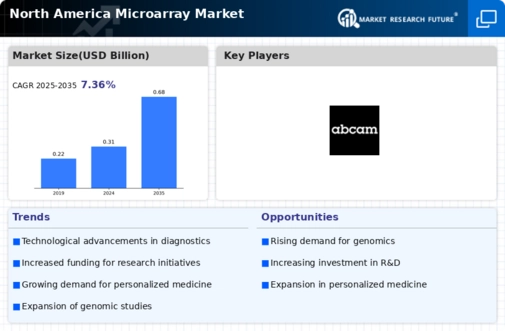Market Trends
Key Emerging Trends in the North America Microarray Market
The North America microarray market is undergoing notable trends driven by technological advancements and increasing applications in genomics and molecular diagnostics. One significant trend in this market is the growing adoption of microarrays in personalized medicine. Microarrays enable the simultaneous analysis of thousands of genes, allowing for the identification of genetic variations and markers associated with individual patient profiles. This trend aligns with the broader shift towards precision medicine, where tailored therapeutic approaches are informed by a deeper understanding of an individual's genetic makeup, contributing to more effective and personalized healthcare.
Advancements in high-throughput technologies are shaping the North America microarray market. The development of microarrays with increased capacity and efficiency allows researchers and clinicians to analyze large datasets more rapidly. This trend is particularly crucial in genomics and transcriptomics research, where high-throughput microarrays play a vital role in unraveling complex biological processes and understanding the molecular basis of diseases.
The integration of microarrays into cancer research and diagnostics is gaining prominence. Microarrays enable the simultaneous analysis of gene expression patterns, copy number variations, and mutations associated with cancer, providing valuable insights into tumor biology and aiding in the identification of potential therapeutic targets. This trend reflects the pivotal role of microarrays in advancing cancer genomics and enhancing the precision of cancer diagnosis and treatment.
The use of microarrays in pharmacogenomics is expanding, contributing to the optimization of drug development and personalized medicine. Microarray technology facilitates the identification of genetic variations that influence drug response, allowing for the development of targeted therapies and the prediction of individual patient responses to specific medications. This trend reflects a shift towards more targeted and efficient drug development, with the potential to improve treatment outcomes and reduce adverse drug reactions.
The increasing adoption of microarrays in agricultural genomics is influencing the market. Microarrays are utilized for analyzing plant genomes, identifying genetic markers associated with desirable traits, and improving crop breeding programs. This trend aligns with the growing importance of genomics in agriculture, aiming to enhance crop yield, resilience, and nutritional content through molecular breeding strategies.
The influence of bioinformatics and data analysis tools in microarray research is becoming more pronounced. As the complexity and volume of data generated by microarrays increase, sophisticated bioinformatics tools are essential for processing, analyzing, and interpreting results. This trend emphasizes the interconnected nature of microarray technology and computational biology, fostering a holistic approach to genomics research.
Global collaborations and partnerships between academic institutions, research organizations, and biotechnology companies are driving innovation in the North America microarray market. These collaborations facilitate the sharing of knowledge, resources, and expertise, contributing to the development of novel microarray technologies and applications. The collective efforts of stakeholders in the genomics community support advancements in microarray research and its translation into clinical and commercial applications.
The integration of microarrays into point-of-care diagnostics is gaining traction. The development of miniaturized and portable microarray platforms allows for rapid and on-site analysis of genetic information, enabling timely diagnosis and personalized treatment decisions. This trend reflects the potential of microarrays to contribute to decentralized and accessible healthcare solutions, particularly in remote or resource-limited settings.
Sustainability considerations are emerging as a factor in the North America microarray market. Manufacturers are exploring environmentally responsible practices in microarray production, including the use of green materials and eco-friendly manufacturing processes. This trend aligns with the broader societal focus on sustainability and highlights the industry's commitment to minimizing its environmental impact.






Leave a Comment